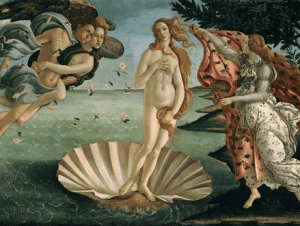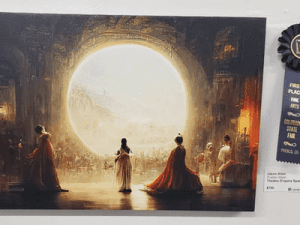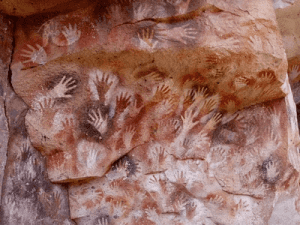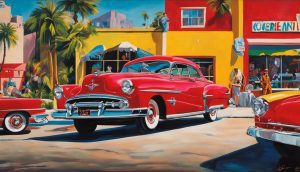
Born: 1571
Died: 1610
Summary of Caravaggio
Caravaggio, also known as Michelangelo Merisi, was an Italian painter regarded as one of the forefathers of modern art.
Caravaggio was an Italian painter who was both controversial and influential. At the age of 11, he was orphaned and apprenticed with a painter in Milan. He relocated to Rome, where his tenebrism style, which employed shadow to accentuate brighter parts, became well-known. His career, on the other hand, was brief. Caravaggio departed Rome after killing a guy in a scuffle. He died on July 18, 1610, not long after.
Caravaggio’s paintings were only equalled in intensity by his erratic lifestyle. He made spectacular, creative paintings and pioneered the use of dramatic lighting and the depiction of holy figures in modern attire and attitudes, despite being a hot-headed, aggressive guy who was frequently in problems with the court and accused of more than one murder. Caravaggio used the close study of his models with the use of powerful beams of light to concentrate emphasis on particular parts of his paintings, contrasting these well-lit regions with dark shadows elsewhere on the canvas, while working from life and without the help of preparatory studies.
Caravaggio’s popular depictions of religious people were innovative, depicting biblical characters in a non-idealized manner by including indications of ageing and poverty, as well as the use of modern clothes. This helped to humanise the holy and make them more approachable to the general public. Caravaggio’s work reflected a sort of spiritual populism in this way. Caravaggio’s figures’ bare, filthy feet linked the artist’s work to church doctrines that stressed Christ’s poverty, as well as requests for simplicity in religious art following the Council of Trent (1545-1563).
Caravaggio was the first painter to use chiaroscuro as a prominent artistic feature, darkening the shadows and employing clearly defined beams of light for emphasis and to accentuate the image’s narrative. In his later work, the style grew more prominent, and it has since been associated with his more mature pictures.
Caravaggio never married and had no children, according to records. This, combined with his many sensuous depictions of young men (along with a dearth of erotic female figures in his work), has sparked a discussion about his sexuality, with a number of current homoerotic readings of his work.
Biography of Caravaggio
Childhood of Caravaggio
Caravaggio was born Michelangelo Merisi da Caravaggio in 1571 in Italy, and his flaming works included “The Death of the Virgin” and “David with the Head of Goliath,” inspiring generations of painters. The environment he stepped into was violent and unsteady at times. His birth occurred barely one week before the Battle of Lepanto, a terrible battle in which Turkish invaders were expelled from Christendom.
Caravaggio’s early family life is mostly unknown. Fermo Merisi, his father, was the marquis of Caravaggio’s steward and architect. The bubonic plague struck Caravaggio when he was six years old, killing virtually everyone in his family, including his father.
The artist’s difficult adult years, according to Andrew Graham-Dixon, author of the 2011 biography “Caravaggio: A Life Sacred and Profane,” sprang directly from the tragic loss of his family. Dixon says, “He almost seems bound to transgress,” “It’s almost as though he can’t help himself from transgressing. He has to do something to sabotage things as soon as he is accepted by authorities, the pope, and the Knights of Malta. It’s almost as if there’s a fatal fault in it.”
Caravaggio was orphaned and wandered the streets, where he found a gang of “painters and swordsmen who lived by the motto nec spe, nec metu, ‘without hope, without fear,'” according to an earlier biographer.
Caravaggio moved to Milan at the age of 11 and began an apprenticeship with the painter Simone Peterzano. An impoverished Caravaggio came to Rome in his late teens, maybe as early as 1588.
To support himself, Caravaggio worked as an assistant to other painters, many of whom were considerably less accomplished than he. Caravaggio, on the other hand, moved from one job to the next as insecurity characterised his existence.
Caravaggio went out on his own in 1595 and began selling his paintings through a dealer. Cardinal Francesco del Monte, who admired Caravaggio’s paintings, promptly placed him in his own home, providing him with lodging, board, and a pension.
Caravaggio was a prolific painter who was noted for working rapidly, frequently starting and finishing a picture in under two weeks. Caravaggio had already completed 40 pieces by the time he came under the influence of del Monte. “Boy with a Basket of Fruit,” “The Young Bacchus” and “The Music Party.” were among the acts on the bill.
Caravaggio’s early paintings frequently showed chubby, attractive young boys dressed as angels, lutenists, or his favourite saint, John the Baptist. Many of the lads in the paintings are either nude or have only a few layers of clothing on. Caravaggio’s sole known helper was a young kid named Cecco, who appears in several of his paintings and may have also been his sweetheart.
Early Life of Caravaggio
Caravaggio was given the commission to decorate the Contarelli Chapel at the San Luigi dei Francesi Church in Rome in 1597. The job of making three big paintings portraying distinct episodes from St. Matthew’s life was both significant and frightening for the 26-year-old painter.
“St. Matthew and the Angel,” “The Calling of St. Matthew,” and “The Martyrdom of St. Matthew,” all completed in 1601, demonstrated Caravaggio’s extraordinary versatility as an artist.
However, both the church and the general people were disturbed by these works. Caravaggio disregarded the customary worshipful portrayals of the saints in his production of the piece, portraying St. Matthew in a considerably more realistic manner. He had to rework his original rendition of “St. Matthew and the Angel” since it created so much grief among his audience.
The commission, on the other hand, presented an intriguing new path for Caravaggio’s painting, allowing him to take classic religious subjects and put them in his own gloomy perspective. His biblical scenarios began to include prostitutes, beggars, and robbers that he had met on Rome’s streets.
The Contarelli Chapel contract gave Caravaggio a lot of visibility and labour, in addition to some financial help. “The Crucifixion of St. Peter,” “The Conversion of St. Paul,” “The Deposition of Christ” and his famed “Death of the Virgin.” were among his works during the following several years. With its representation of the Virgin Mary with a large tummy and bared legs, the latter was turned down by the Carmelites and ended up in the hands of the Duke of Mantua.
Mid-Life of Caravaggio
Caravaggio’s fame, on the other hand, was driven by controversy. And as the painter’s fame increased, so did his personal problems. He may be an aggressive individual with extreme mood swings and a penchant for drinking and gambling.
Following an allegation from another painter that Caravaggio had assaulted him, Caravaggio was sentenced to a brief jail sentence in 1603. However, Caravaggio’s anger only became hotter over the next few years. Throwing a platter of artichokes at a waiter in 1604 and assaulting Roman guards with stones in 1605 were only two of his many attacks. “After a fortnight’s work he will swagger about for a month or two with a sword at his side and a servant following him, from one ballcourt to the next, ever ready to engage in a fight or an argument.” wrote one witness.
In 1606, he killed a well-known Roman pimp called Ranuccio Tomassoni, bringing his brutality to a head. Historians have theorised for a long time about what caused the atrocity. Some speculated that it was related to an unpaid debt, while others said that it was the consequence of a disagreement over a tennis match. Caravaggio’s passion for Tomassoni’s wife, Lavinia, has lately been highlighted by scholars such as Andrew Graham-Dixon.
On The Run
Following the murder, Caravaggio departed Rome and sought sanctuary in a variety of places, including Naples, Malta, and Sicily. Caravaggio’s popularity followed him even as he escaped punishment for his crime. He was inducted into the Order of Malta as a Knight of Justice in Malta, but when the Order heard of the crime he had committed, he was deprived of the honour.
Caravaggio, on the other hand, continued to work even as he fled. In Naples, he painted “Madonna of the Rosary” for the church of Pio Chapel of Monte della Misericordia, and subsequently “The Seven Works of Mercy” for a fellow painter.
For the cathedral of Valletta, he produced “Beheading of St. John the Baptist” He painted “The Resurrection of Lazarus” and “The Adoration of the Shepherds,” in Messina, and “Adoration with St. Francis and St. Lawrence.” in Palermo.
“Resurrection,” a painting by Caravaggio depicting a less holy, more bedraggled Jesus Christ escaping from his tomb in the middle of the night, is one of his more startling works from this era. Caravaggio’s personal circumstances were undoubtedly the inspiration for this picture. Caravaggio had become a neurotic mess by this time, always on the run and terrified for his life, to the point that he slept with his clothes on and a knife at his side.
Late Life of Caravaggio
Caravaggio’s murder in 1606 was not the last act of his vengeance. In July 1608, he assassinated Fra Giovanni Rodomonte Roero, one of the Order of St. John’s most senior knights in Malta. Caravaggio was apprehended and imprisoned for the attack, but he managed to flee after only a month.
Roero did not put the incident behind him, according to Andrew Graham-study. Dixon’s He pursued Caravaggio to Naples in 1609 and attacked him outside a bar, disfiguring his face.
Caravaggio’s emotional and physical health were severely impacted by the incident. As demonstrated by two of his later works, “The Martyrdom of Saint Ursula” and “The Denial of Saint Peter.” his vision and brushwork were harmed by the assault.
Caravaggio’s sole hope of avoiding punishment for murder was with the Pope, who had the ability to pardon him. Caravaggio began making his way back to Rome in 1610, most likely after learning that supporters were working on his behalf to win his pardon. He was apprehended at Palo, where his boat had come to a halt, while sailing from Naples. He resumed his voyage after his release and arrived at Port’Ercole on July 18, 1610, where he died just a few days later.
The actual reason of Caravaggio’s death has been a mystery for many years. However, in 2010, experts studying Caravaggio’s remains revealed that his bones had significant quantities of lead, which they believe drove the painter insane.
Despite being ostracised after his death, Caravaggio was later regarded as one of the founding fathers of modern painting. From Diego Velazquez to Rembrandt, his art had a huge effect on future masters. In 2010, an exhibition of his art in Rome commemorating the 400th anniversary of his death drew over 580,000 people.
Caravaggio Facts
What is Caravaggio most known for?
During the late 1500s and early 1600s, Caravaggio was a well-known yet divisive Italian painter. A few of his more well-known works include Sick Bacchus, The Musicians, The Skull of Medusa, St. Paul’s Conversion, The Entombment of Christ, and St. John the Baptist with a sword in his head.
Was Caravaggio named after Michelangelo?
Michelangelo Merisi was the artist’s birth name, but he was given the surname Caravaggio in honour of the place where he spent a large part of his boyhood.
Is Caravaggio a serial killer?
Murderer and Notorious Criminal: Italian Painter. With his tongue and blade, the artist was able to inflict serious harm on his victims. In a few of seconds, the artist could inflict serious harm with both his tongue and blade.
What bad things did Caravaggio do?
When it comes to Caravaggio’s criminal record—which includes everything from fighting with a waiter over an artichoke dish to harassing his landlady and disfiguring a courtesan who turned him down—a there’s lot to learn.
Famous Caravaggio Paintings
The Calling of St. Matthew
1600

This painting was created for the lateral wall of the Contarelli Chapel in the Roman church San Luigi dei Francesi, and it was Caravaggio’s first significant public works contract. The Martyrdom of St. Matthew is one of two companion works showing different moments from St. Matthew’s life. Caravaggio shows a scene from Matthew’s Gospel in which Christ, joined by St. Peter, invites the tax collector Matthew to become a follower of Jesus. Matthew has been recognised in a variety of ways. The bearded centre figure, according to most interpretations, is Matthew, since his gesture, a hand with an extended finger pointing towards his breast, appears to question “who me?”
The Entombment/Deposition
1604

The Entombment was originally painted for the Santa Maria in Vallicella Oratorian cathedral in Rome. Mourners carry Christ’s body to the tomb, with John the Evangelist in a crimson cloak holding Christ’s torso and Nicodemus carrying Christ’s legs. Christ is accompanied to his burial by a distressed Mary of Clopas, a crying Mary Magdalene, and a bent Virgin Mary. The figures are depicted with a realism that belies their religious significance, and this is emphasised by the image’s red and brown tones (typical of Caravaggio’s palette at the time), which help to emphasise the participants’ earthy normalcy.
The Beheading of St. John the Baptist
1608

The Oratory of San Giovanni Decollato, attached to the Church of St. John in Valletta, Malta, commissioned Caravaggio to create this altarpiece. It is widely regarded as one of Caravaggio’s best works, and it is possible that it was his passaggio, a gift given after initiation into the Order of the Knights of Malta. This painting is remarkable for being Caravaggio’s only signed work. According to art historian Keith Sciberras, the blood from John’s skull flows into the artist’s signature as ‘Fra Michael Angelo,’ a centred signature that indicates the artist’s new social rank as Michelangelo, Knight of Malta.
BULLET POINTED (SUMMARISED)
Best for Students and a Huge Time Saver
- Caravaggio, also known as Michelangelo Merisi, was an Italian painter regarded as one of the forefathers of modern art.
- Caravaggio was an Italian painter who was both controversial and influential.
- At the age of 11, he was orphaned and apprenticed with a painter in Milan.
- He relocated to Rome, where his tenebrism style, which employed shadow to accentuate brighter parts, became well-known.
- His career, on the other hand, was brief.
- Caravaggio departed Rome after killing a guy in a scuffle.
- He died on July 18, 1610, not long after.
- Caravaggio’s paintings were only equaled in intensity by his erratic lifestyle.
- He made spectacular, creative paintings and pioneered the use of dramatic lighting and the depiction of holy figures in modern attire and attitudes, despite being a hot-headed, aggressive guy who was frequently in problems with the court and accused in more than one murder.
- Caravaggio used close study of his models with the use of powerful beams of light to concentrate emphasis on particular parts of his paintings, contrasting these well-lit regions with dark shadows elsewhere on the canvas, while working from life and without the help of preparatory studies.
- Caravaggio’s popular depictions of religious people were innovative, depicting biblical characters in a non-idealized manner by including indications of ageing and poverty, as well as the use of modern clothes.
- This helped to humanise the holy and make them more approachable to the general public.
- Caravaggio’s work reflected a sort of spiritual populism in this way.
- Caravaggio’s figures’ bare, filthy feet linked the artist’s work to church doctrines that stressed Christ’s poverty, as well as requests for simplicity in religious art following the Council of Trent (1545-1563).
- Caravaggio was the first painter to use chiaroscuro as a prominent artistic feature, darkening the shadows and employing clearly defined beams of light for emphasis and to accentuate the image’s narrative.
- In his later work, the style grew more prominent, and it has since been associated with his more mature pictures.
- Caravaggio never married and had no children, according to records.
- This, combined with his many sensuous depictions of young men (along with a dearth of erotic female figures in his work), has sparked a discussion about his sexuality, with a number of current homoerotic readings of his work.
Born: 1571
Died: 1610
Information Citations
En.wikipedia.org, https://en.wikipedia.org/.
Recommend0 recommendationsPublished in Art History, Artists, Resources







Responses